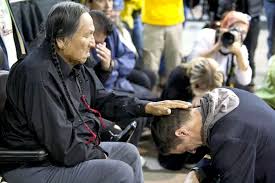Standing Rock:
A Veteran’s Day Reflection
Nearly four years ago, I answered a call to serve as a chaplain to the Standing Rock community. This call was issued by the elders and leaders of Standing Rock for a specific reason: more than 4,000 U.S. military veterans were coming to Oceti Sakowen — which at several hundred people was the largest of the Standing Rock camps — and the elders and leaders knew that many of these veterans would arrive with PTSD. A traumatic incident was of particular concern since one of the intentions of these veterans was to become a “human shield” between the armed personnel that accompanied the Dakota Access Pipeline (DAPL) and the Standing Rock water protectors. The helicopters buzzing overhead, the flash grenades, the tear gas, the face shields, the armored vehicles, the body armor, and the guns – each had been directed at the water protectors before and each could have triggered a trauma response. Into this context and in the spirit of non-violence, I went to pray and pastor to these Native people and veterans fighting to protect our waters and lands and to uphold our nation’s treaties even at great personal and bodily risk.
Instead of stepping into a war zone, I entered into moments of peaceful prayer, celebration, and reconciliation. What was powerful about Standing Rock was not only that this gathering was able to block this pipeline, was not only that this was the first time in over 100 years that these seven tribal councils gathered in ceremony and lit a sacred fire, but that it also included the peaceful and healing presence of veterans and their acts of atonement.
This was not a reductionist, binary situation: natives versus military. Native Americans serve in the U.S. military at a higher rate than any other demographic group. Many of the veterans that came to the camp were First Nation people, and many of the indigenous people there were veterans. I talked to them about many things. One group gathered around a campfire shared that they wouldn’t use the term “militarized” to describe the armed forces that accompanied the building of the DAPL, for in their experience the military had and followed an honorable code of conduct that prohibited violence against unarmed civilians such as the water protectors. I listened as a young man vulnerably shared how at Oceti Sakowen he discovered pride in his heritage and identity. Others spoke gently about the transformational power of peaceful prayer and traditional rituals– not only for spiritual well-being, or maintaining non-violence but also as a means to remain sober despite alcoholism. Though many veterans wanted to put their bodies on the line, as a human shield, they listened to tribal leaders who urged de-escalation, non-violence, and non-confrontation. We choose community instead of confrontation. And because of that choice, we were all right there, celebrating at the sacred fire as the news came in that the U.S. Army Corp of Engineer had denied the final permit to DAPL, and would begin exploring alternate routes. Joy added to joy, as the people danced, cried, and cried out, sang, and chanted together.
The next day, former Army Lt. Wesley Clark Jr., son of Gen. Wesley Clark, former Supreme Allied Commander of NATO, represented the thousands of former service members that journey with him in a formal “forgiveness ceremony.” Kneeling before assembled tribal elders on the reservation land that Sitting Bull was confined to and murder on, Clark spoke:
“Many of us, me particularly, are from the units that have hurt you over the many years. We came. We fought you. We took your land. We signed treaties that we broke. We stole minerals from your sacred hills. We blasted the faces of our presidents onto your sacred mountain. Then we took still more land and then we took your children and … we tried to eliminate your language that God gave you, and the Creator gave you. We didn’t respect you, we polluted your Earth, we’ve hurt you in so many ways but we’ve come to say that we are sorry.”
Chief Leonard Crow Dog put his hand on Clark’s head. It was not the end, a closure, but rather a beginning of right relationship. The elders embraced Clark, and then those by his side. There was movement, as Clark and the elders greeted one another as siblings. Then naturally and with invitation, we all began winding through the room, as though a river carried us. Each of us was embraced. Arms would enfold me, “Thank you for coming, sister. You are needed here.” A tear of release flowed, a connection was unleashed.
In light of all this, the term “veteran” seems inadequate. What I know is this: human stories are deep, complex, nuanced, and best experienced. We are capable of much destruction, but I think we are capable of equal transformation.

